3-Hydroxy-1-AdaMantane Carboxylic AcidCAS NO.: 42711-75-1 CAS NO.42711-75-1
- FOB Price: USD: 2.00-2.00 /Metric Ton Get Latest Price
- Min.Order: 1 Gram
- Payment Terms: L/C,D/A,D/P,T/T,Other
- Available Specifications:
top grade (1-10)Metric Tontop grade (1-10)Metric Tontop grade (1-10)Metric Ton
- Product Details
Keywords
- 3-Hydroxy-1-AdaMantane Carboxylic Acid
- 1-Carboxy-3-adamantanol
- 3-Carboxyadamantan-1-ol
Quick Details
- ProName: 3-Hydroxy-1-AdaMantane Carboxylic Acid...
- CasNo: 42711-75-1
- Appearance: Colorless liquid
- Application: Synthetic fragrances
- DeliveryTime: In stock
- PackAge: drum
- Port: China main port
- ProductionCapacity: 10000 Metric Ton/Month
- Purity: 99%
- Storage: Room temperature
- Transportation: By Sea/Air/DHL
- LimitNum: 1 Gram
- first class: 1-10
Superiority
we are leading fine chemicals supplier in China and we had established stable business relationships with Samsung,LG,Merck,Thermo Fisher Scientific and so on.Our main business covers the fields below:
1.Noble Metal Catalysts (Pt.Pd...)
2.Organic Phosphine Ligands (Tert-butyl-phosphine.Cyclohexyl-phosphine...)
3.OLED intermediates (Fluorene,Carbazole,Boric acid...)
4.Customs Synthesis
Our advantage:
1.Higest quality and good package
2.Fast delivery
3.Better payment term
4.Fast response to customer within 6 hours
5.Good business credit in Europe ,US ,Japan ,Korea
Anyway ,if you need any chemicals from China ,Henan Wentao can help you
Details
| 3-Hydroxy-1-AdaMantane Carboxylic Acid Usage And Synthesis |
| Chemical Properties | White to yellow solid |
| Uses | 3-Hydroxy-1-AdaMantane Carboxylic Acid is used in the synthesis of potent pyridyl amide/sulfonamide inhibitors of 11β-HSD-1 which could be applied to a treatment of ulcers or in hormone therapy treatments relating t o cortisol. |
| Uses | 1-Carboxy-3-adamantanol is used in the synthesis of potent pyridyl amide/sulfonamide inhibitors of 11β-HSD-1 which could be applied to a treatment of ulcers or in hormone therapy treatments relating to cortisol. |
| Synthesis Reference(s) | Synthetic Communications, 18, p. 1967, 1988 DOI: 10.1080/00397918808068263 |


 Diamondsupplier
Diamondsupplier 



